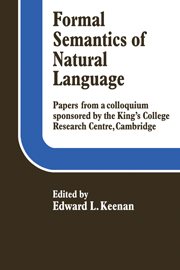Book contents
- Frontmatter
- Contents
- Notes on the contributors
- Acknowledgements
- Introduction
- I QUANTIFICATION IN NATURAL LANGUAGE
- II REFERENCE AND CROSS REFERENCE
- III INTENSIONAL LOGIC AND SYNTACTIC THEORY
- IV QUESTIONING MODEL THEORETIC SEMANTICS
- V PRAGMATICS AND SENTENCES IN CONTEXT
- VI SEMANTICS AND SURFACE SYNTAX
- Arguments for assigning tense meanings after certain syntactic transformations apply
- Towards a formal treatment of the phenomenon of aspect
- On the relations between syntax and semantics
- Logical expressive power and syntactic variation in natural language
On the relations between syntax and semantics
Published online by Cambridge University Press: 05 November 2011
- Frontmatter
- Contents
- Notes on the contributors
- Acknowledgements
- Introduction
- I QUANTIFICATION IN NATURAL LANGUAGE
- II REFERENCE AND CROSS REFERENCE
- III INTENSIONAL LOGIC AND SYNTACTIC THEORY
- IV QUESTIONING MODEL THEORETIC SEMANTICS
- V PRAGMATICS AND SENTENCES IN CONTEXT
- VI SEMANTICS AND SURFACE SYNTAX
- Arguments for assigning tense meanings after certain syntactic transformations apply
- Towards a formal treatment of the phenomenon of aspect
- On the relations between syntax and semantics
- Logical expressive power and syntactic variation in natural language
Summary
One of the main objectives of traditional grammarians was to relate form and meaning. This programme ran into many difficulties and was abandoned by structural linguists who found it much more fruitful to concentrate on the voluntarily limited study of the combinatorial properties of words.
Transformational linguists also exclude meaning from the grammar rules they build. However, the definition of a transformational rule (unlike the definition of a distributional rule) explicitly involves meaning, since transformationally related sentences must have identical meanings.
There are important differences in the ways we just referred to the term ‘meaning’. Traditional grammars classify forms into families, and attribute to these families absolute categories of meanings. For example, the notion of phrase is a notion of form, so is the notion of when-phrase (i.e. adverbial phrase whose left-most word is when). Often, the semantic notion /time/ is associated with these forms (i.e. adverbs of time).
The modern formalized version of this activity is usually stated in the general framework of formal logic. On the one hand, the syntactic rules of some formal system define a set of well-formed formulae (here sentence forms), on the other hand, a semantic model provides interpretation for each formula. As in mathematical logic, the question of setting up a dividing line between the syntactic theory and its model constantly arises. In both the traditional and the formal approach, absolute notions of meaning are needed to interpret the sentences.
- Type
- Chapter
- Information
- Formal Semantics of Natural Language , pp. 389 - 405Publisher: Cambridge University PressPrint publication year: 1975
- 2
- Cited by



